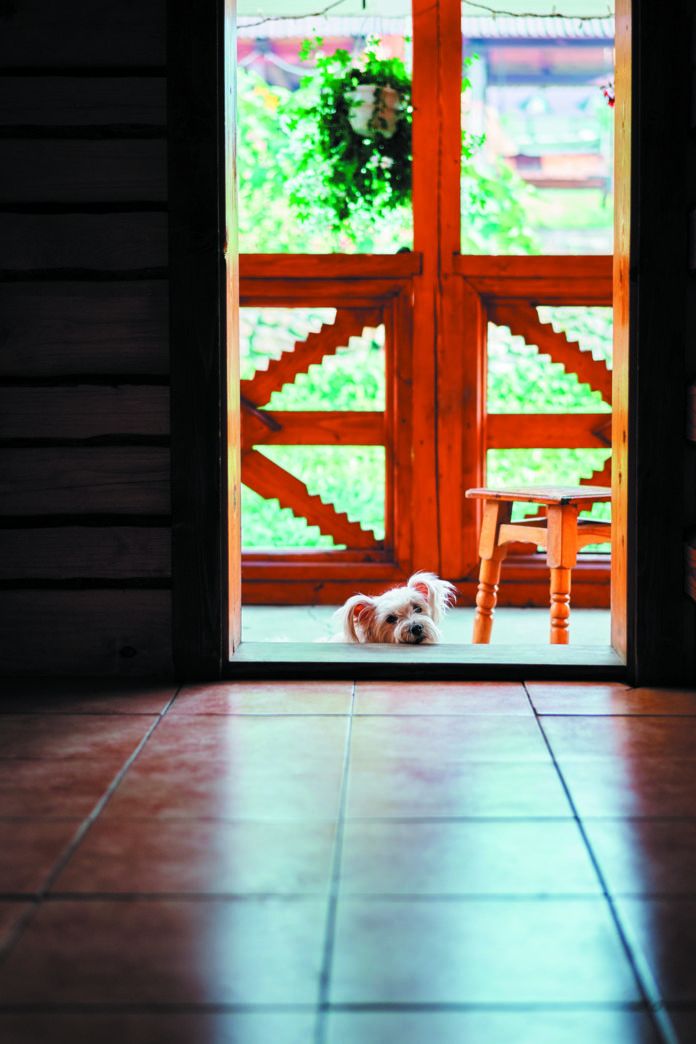Seemingly out of nowhere, your older dog balks about walking from the family room to the kitchen, or jumps over the back-door threshold to go outside as though there is an electric jolt under her feet.
Because threshold or doorway fear is a common issue with dogs experiencing canine cognitive dysfunction that can come with old age, you might automatically assume your dog’s senior status is the cause of her changed behavior. But it’s not necessarily that at all. “There are many reasons dogs are reluctant to cross thresholds,” says Stephanie Borns-Weil, DVM, head of the Tufts Animal Behavior Clinic. It doesn’t have to have anything to do with age; there are plenty of younger dogs who fear crossing from one room to another, or from inside to outside.
Treacherous conditions. Sometimes the problem is a change from room to room in how things feel underfoot. “Some dogs may not appreciate the flooring on the other side of the doorway if it is slippery,” says Dr. Borns-Weil. For instance, they may have trouble transitioning from carpet to highly polished wood flooring. Or perhaps there are steps leading to the threshold that are not covered and make her uneasy while she’s climbing up or down, the doctor explains.
Visual cues. Dogs’ depth perception is limited compared to humans’ due to the fact that their eyes are farther apart than ours. That eye placement is great for scanning wide terrain but not as good for navigating close-up spaces. So what to you is an innocuous strip of wood between two rooms might be a worrisome divide to your dog, one that appears as a real barrier rather than simply an aesthetic demarcation. If your dog has difficulty recognizing how raised a curved doorway saddle is, she may jump over it as though it is a true obstacle — or try to avoid it altogether, especially if the flooring on the other side won’t give her any traction.
Scary associations. You might wonder why a doorway can become a problem all of a sudden when everything had been fine for years. But the dog may have had a negative experience that you missed but which has stuck in her mind, and she can’t get past it. Perhaps a door bumped your pet as she passed it, or she stubbed her paw by accident on a raised threshold. Or maybe one time, just as she was leaving the house for a walk, a scary, aggressive dog from up the street starting barking at her. Or a firetruck zoomed down the street with lights flashing and siren blaring.
“Like humans, dogs are at risk of generalizing their fears,” Dr. Borns-Weil says. “One bad experience with a threshold can trigger lasting uneasiness with that particular threshold or even others, just as one really bumpy flight can make it hard for more vulnerable people to get on a plane again,” the doctor says.
How to ease the transition from one room to the next
Treatment begins with ruling out medical problems — or treating them if they’re found. Sometimes arthritis medicine or a weight-loss plan can make a dog more physically comfortable moving from one room to another, especially if there are stairs or slippery surfaces involved. Even a resolution of pain from something like an ear infection may make a dog more willing to cross thresholds again. Pain can really limit willingness, along with mobility.
Physical modifications sometimes prove useful, too. “If a dog is fearful of a threshold because she might have tripped over it, then covering the threshold with a runner will be helpful,” says Dr. Borns-Weil. “If the problem is that she fears a slippery floor on the other side of the doorway, you can put down a yoga mat or runner to ease her anxiety and make it easier to cross over.” Such solutions might not be aesthetically to your liking, but what is more important — the look of your home or your dog’s comfort and knowledge that you are taking steps on her behalf?
If the issue is strictly behavioral rather than physical or medical, it falls to you to try to figure out the unpleasant association your dog has made with going through a doorway and make modifications to ease her anxiety. Perhaps curtains blow as she crosses from one space to another, and that unnerves her. Or a space feels too cluttered to her. Or a neighbor’s dog barks and lunges from the safety of his own yard, leaving your pet intimidated. Can you take your dog out through the front door instead? Or put up a fence or other barrier that will keep your pet from seeing the aggressive dog? Can you remove some things that have accumulated near the doorway? You could even carry your pet to what she perceives as a safe distance from the problem, provided she is not too large.
If you can’t get to the bottom of what triggered her reluctance to cross from room to room, you can work to make crossing a threshold a more positive experience, perhaps cajoling her with treats and speaking to her in a high-pitched voice. That could help change her association with the doorway from something negative to something positive.
Whatever you do, don’t show annoyance or anger. Your dog is truly worried. Letting her know that her fear is getting on your nerves will only make her unhappy — and all the more anxious.
Sometimes age does turn out to be the cause of a dog’s problem with doorways. “Senility can leave a pet confused about where she is or about whether a threshold is passable,” says Dr. Borns-Weil. But usually, such signs of confusion or disorientation come in clusters. One way to know whether hesitation at doorways is about canine cognitive dysfunction, the behaviorist says, is to ascertain whether the dog is showing other signs of confusion as well — perhaps staring blankly at walls, having trouble recognizing familiar people, and becoming less able to respond to your usual cues.
Advancing years can also cause threshold difficulties that have nothing to do with senility. Geriatric pets, like geriatric people, are likely to have decreased mobility and eyesight. “They may start to be wary about certain places in their home that were not problems before,” says Dr. Borns-Weil. You might find an arthritic dog eventually avoiding a threshold if it’s painful to step over it or she has to change her gait in some way to cross it.






This is a great article. Fear of thresholds was one sign of a brain tumor in my dog. His vision had been compromised by the tumor right before the tumor was diagnosed about a couple of days, he developed this fear. Pay attention to this symptom and do not take it lightly-a trip to the vet can be warranted.
We have a sleepover Greyhound who refuses to go out to the yard from the kitchen and thru the garage to the porch/yard. However, if I take him out the front door to the yard, no problem. His owners said he has hesitation with steps going outside too. He’s a beautiful 5-year old fawn boy, loves to go on walks, play with toys, and enjoys other Greyhounds. His fear is baffling 🤔